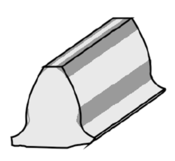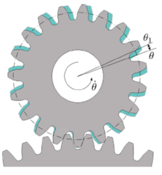Dynamic Analysis of Power Transmission
MSC in Mechanical Engineering - Supervisor: Prof. Carlo Rosso - Student: Francesco d’Addato
This thesis work deals with the analysis of the dynamic behavior of gears related to the engaging problem. It concerns reliability and endurance and if not properly governed can lead to the failure of the mechanical system in service. The damage mechanisms are generated by system kinematic (such as the cyclic variation of load due to gears rotation) and by system flexibility. The former can lead to fatigue in root fillet or in contact surface but it is intrinsic of the nature of mating gear and it is not possible to avoid it. The latter can induce overloads, noise and irregularity of motion and it can be at least limited by acting on the design properties of the gears in such a way to reduce noise and vibrations and increase the lasting of the system as well.
The major focus is on the transmission error which sums up all the irregularities coming from the tooth mating. In fact, due to the flexibility or to the oscillation of the wheeled gear or to the manufacturing error, the mating teeth could lose contact on the action drive side of the profile and can have contact on the coast side of the profile. In this way, the force exchanged at the contact implies displacements of the contact point along the line of action. Theoretically, such displacement is defined as the angular rotation of the gear times the base radius: in ideal conditions (when no positioning error is there and when a rigid engagement is considered), the displacements are equal: . But, in real life, irregularities are there and the transmission error comes defined as the inequality that could rise from the previous equation: .
The irregularities coming from the teeth mating are investigated by using the Machinery Advanced 3D Contact toolkit from the latest version of Adams View which mixes up the Multibody analysis and the Finite Elements Method, obtaining a Multi Flexible Body Dynamics model. As a consequence, both the micro and the macro geometrical features of the gears are taken into account, as well as the complex deformation of the gearbox components and the time evolution of the engagement. It is exactly the basic criteria that links all the simulations developed throughout this work.
The gear pair under investigation consists in a spur gear pair from an accessory gearbox. The analysis starts focusing on the simplified model that deals with the base profile of the tooth where no modification was made. It will be used as a comparison with the modified profile that is going to be built afterwards. This is the final result of the investigated model:
Once the model is set up, it is set the resistant torque to the wheel and the motion to the pinion.
All the analysis are conducted examining two different modeling option: the Rigid gear modeling option and the RunTime modeling option. The former allows to set the value of the contact stiffness that is used in the contact algorithm: in fact, the simulations here are conducted increasing the contact stiffness from a value of 104 N/mm*rad to a value of 105 N/mm*rad and to a value of 106 N/mm*rad. The latter, time by time, consists in the stiffness contact calculation of the finite elements fragmentation of the tooth structure. Both modeling options are investigated in static and dynamic conditions. When gears slowly move and the conditions can be considered as quasi-static (0.2 rad/s), it is possible to evaluate the static transmission error which derives from the deformation of the tooth itself and from compliance of all the system components. Instead, when operating at high speed ranges (9,000 rpm) the dynamic transmission error is investigated . It is the most studied, since it is the output from the models used to analyze gear dynamics. Also, it is considered as the source of noise and vibration in gear transmission. Above all, a special attention is paid to the peak to peak transmission error, the PPTE, that is the difference between the maximum and the minimum value of the transmission error. The PPTE is amplified by the load and the low quality of the tooth profile: it is the main parameter to be controlled, being illustrative of the quality of the power transmission. The purpose of such analysis is to evaluate how the PPTE reduces when a proper modification to the tooth profile is made. The modification consists in tip and root relief: the material from the tip and from the root of both flanks of the tooth is linearly removed, maintaining the involute profile of the tooth. For this case, they actually consists in microns of material removal.


The modifications to the tooth profile leads to a reduction of the PPTE, in each modeling option (not depending on the stiffness of the contact) for both static and dynamic conditions. As already discussed, it allows a reduction in vibrations and thus a better propagation of motion of the whole system. Here follows the best results from the static and the dynamic analysis:

Summarizing, this work highlights how innovative MFBD simulation methodologies constitute an accurate and efficient tool as a support to the mechanical designer task. In such context, FEM and MB analysis are two among the most consolidated and used approaches; they can be integrated by means of the software Adams View, getting benefits from the best features of each one. Adopting this criteria, the user can use one only software to study different aspects of the same system. In this particular case, it is possible to achieve good results in both tooth deformation and mating dynamics, with an acceptable computational weight.


